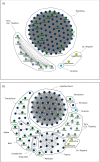Genomic diversity across the Rickettsia and 'Candidatus Megaira' genera and proposal of genus status for the Torix group
- PMID: 35551207
- PMCID: PMC9098888
- DOI: 10.1038/s41467-022-30385-6
Genomic diversity across the Rickettsia and 'Candidatus Megaira' genera and proposal of genus status for the Torix group
Abstract
Members of the bacterial genus Rickettsia were originally identified as causative agents of vector-borne diseases in mammals. However, many Rickettsia species are arthropod symbionts and close relatives of 'Candidatus Megaira', which are symbiotic associates of microeukaryotes. Here, we clarify the evolutionary relationships between these organisms by assembling 26 genomes of Rickettsia species from understudied groups, including the Torix group, and two genomes of 'Ca. Megaira' from various insects and microeukaryotes. Our analyses of the new genomes, in comparison with previously described ones, indicate that the accessory genome diversity and broad host range of Torix Rickettsia are comparable to those of all other Rickettsia combined. Therefore, the Torix clade may play unrecognized roles in invertebrate biology and physiology. We argue this clade should be given its own genus status, for which we propose the name 'Candidatus Tisiphia'.
© 2022. The Author(s).
Conflict of interest statement
The authors declare no competing interests.
Figures






Similar articles
-
Torix Rickettsia are widespread in arthropods and reflect a neglected symbiosis.Gigascience. 2021 Mar 25;10(3):giab021. doi: 10.1093/gigascience/giab021. Gigascience. 2021. PMID: 33764469 Free PMC article.
-
A newly recorded Rickettsia of the Torix group is a recent intruder and an endosymbiont in the whitefly Bemisia tabaci.Environ Microbiol. 2020 Apr;22(4):1207-1221. doi: 10.1111/1462-2920.14927. Epub 2020 Feb 5. Environ Microbiol. 2020. PMID: 31997547
-
Incidence and Diversity of Torix Rickettsia-Odonata Symbioses.Microb Ecol. 2021 Jan;81(1):203-212. doi: 10.1007/s00248-020-01568-9. Epub 2020 Aug 7. Microb Ecol. 2021. PMID: 32770272 Free PMC article.
-
Rickettsial evolution in the light of comparative genomics.Biol Rev Camb Philos Soc. 2011 May;86(2):379-405. doi: 10.1111/j.1469-185X.2010.00151.x. Epub 2010 Aug 17. Biol Rev Camb Philos Soc. 2011. PMID: 20716256 Review.
-
The emerging diversity of Rickettsia.Proc Biol Sci. 2006 Sep 7;273(1598):2097-106. doi: 10.1098/rspb.2006.3541. Proc Biol Sci. 2006. PMID: 16901827 Free PMC article. Review.
Cited by
-
Structural determination of Rickettsia lipid A without chemical extraction confirms shorter acyl chains in later-evolving spotted fever group pathogens.mSphere. 2024 Feb 28;9(2):e0060923. doi: 10.1128/msphere.00609-23. Epub 2024 Jan 23. mSphere. 2024. PMID: 38259062 Free PMC article.
-
Amoebae as training grounds for microbial pathogens.mBio. 2024 Aug 14;15(8):e0082724. doi: 10.1128/mbio.00827-24. Epub 2024 Jul 8. mBio. 2024. PMID: 38975782 Free PMC article. Review.
-
Comparative genomics of a novel Erwinia species associated with the Highland midge (Culicoides impunctatus).Microb Genom. 2024 Apr;10(4):001242. doi: 10.1099/mgen.0.001242. Microb Genom. 2024. PMID: 38630610 Free PMC article.
-
Genomic analysis of co-infection with Wolbachia and Candidatus Tisiphia in the sand fly Sergentomyia squamirostris.Front Microbiol. 2025 May 9;16:1577636. doi: 10.3389/fmicb.2025.1577636. eCollection 2025. Front Microbiol. 2025. PMID: 40454368 Free PMC article.
-
Metagenomics of culture isolates and insect tissue illuminate the evolution of Wolbachia, Rickettsia and Bartonella symbionts in Ctenocephalides spp. fleas.Microb Genom. 2023 Jul;9(7):mgen001045. doi: 10.1099/mgen.0.001045. Microb Genom. 2023. PMID: 37399133 Free PMC article.
References
-
- Boettcher KJ, Ruby EG, McFall-Ngai MJ. Bioluminescence in the symbiotic squid Euprymna scolopes is controlled by a daily biological rhythm. J. Comp. Physiol. A. 1996;179:65–73. doi: 10.1007/BF00193435. - DOI
Publication types
MeSH terms
Associated data
Grants and funding
LinkOut - more resources
Full Text Sources
Research Materials

